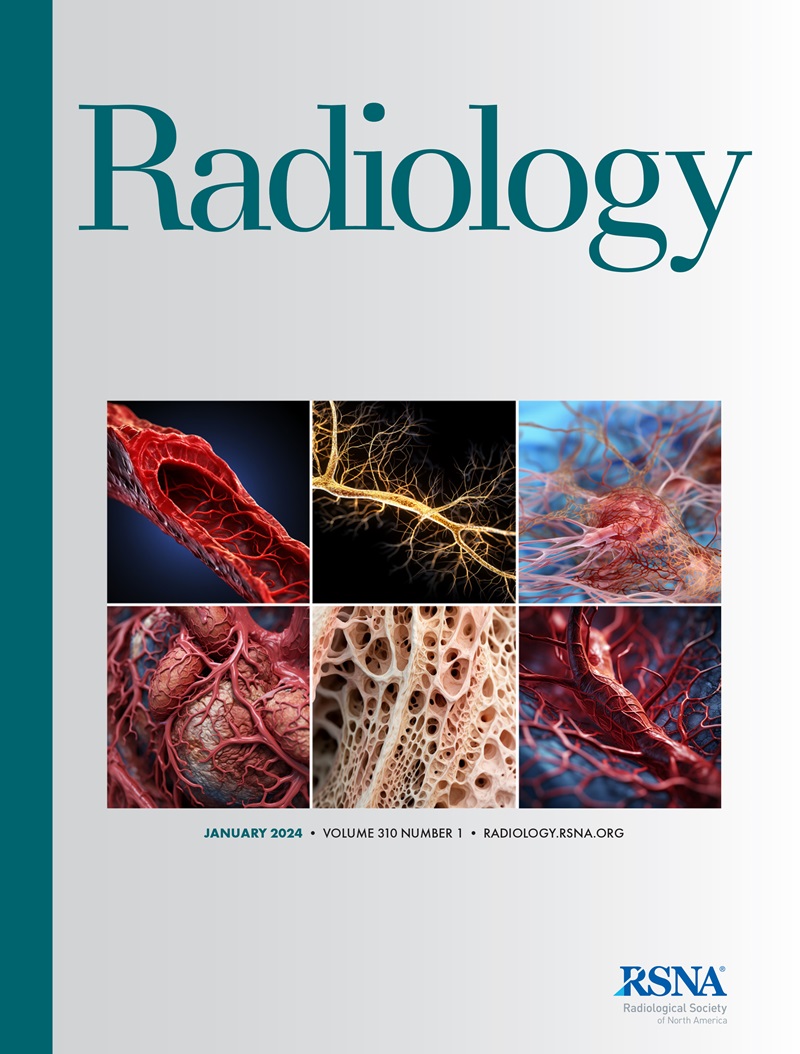下载PDF
{"title":"对乳房极度致密、罹患乳腺癌风险较高的女性进行乳房 X 线造影检查的诊断准确性。","authors":"Noam Nissan, Christopher E Comstock, Varadan Sevilimedu, Jill Gluskin, Victoria L Mango, Mary Hughes, R Elena Ochoa-Albiztegui, Janice S Sung, Maxine S Jochelson","doi":"10.1148/radiol.232580","DOIUrl":null,"url":null,"abstract":"<p><p>Background Mammogram interpretation is challenging in female patients with extremely dense breasts (Breast Imaging Reporting and Data System [BI-RADS] category D), who have a higher breast cancer risk. Contrast-enhanced mammography (CEM) has recently emerged as a potential alternative; however, data regarding CEM utility in this subpopulation are limited. Purpose To evaluate the diagnostic performance of CEM for breast cancer screening in female patients with extremely dense breasts. Materials and Methods This retrospective single-institution study included consecutive CEM examinations in asymptomatic female patients with extremely dense breasts performed from December 2012 to March 2022. From CEM examinations, low-energy (LE) images were the equivalent of a two-dimensional full-field digital mammogram. Recombined images highlighting areas of contrast enhancement were constructed using a postprocessing algorithm. The sensitivity and specificity of LE images and CEM images (ie, including both LE and recombined images) were calculated and compared using the McNemar test. Results This study included 1299 screening CEM examinations (609 female patients; mean age, 50 years ± 9 [SD]). Sixteen screen-detected cancers were diagnosed, and two interval cancers occured. Five cancers were depicted at LE imaging and an additional 11 cancers were depicted at CEM (incremental cancer detection rate, 8.7 cancers per 1000 examinations). CEM sensitivity was 88.9% (16 of 18; 95% CI: 65.3, 98.6), which was higher than the LE examination sensitivity of 27.8% (five of 18; 95% CI: 9.7, 53.5) (<i>P</i> = .003). However, there was decreased CEM specificity (88.9%; 1108 of 1246; 95% CI: 87.0, 90.6) compared with LE imaging (specificity, 96.2%; 1199 of 1246; 95% CI: 95.0, 97.2) (<i>P</i> < .001). Compared with specificity at baseline, CEM specificity at follow-up improved to 90.7% (705 of 777; 95% CI: 88.5, 92.7; <i>P</i> = .01). Conclusion Compared with LE imaging, CEM showed higher sensitivity but lower specificity in female patients with extremely dense breasts, although specificity improved at follow-up. © RSNA, 2024 See also the editorial by Lobbes in this issue.</p>","PeriodicalId":20896,"journal":{"name":"Radiology","volume":"313 1","pages":"e232580"},"PeriodicalIF":12.1000,"publicationDate":"2024-10-01","publicationTypes":"Journal Article","fieldsOfStudy":null,"isOpenAccess":false,"openAccessPdf":"https://www.ncbi.nlm.nih.gov/pmc/articles/PMC11535862/pdf/","citationCount":"0","resultStr":"{\"title\":\"Diagnostic Accuracy of Screening Contrast-enhanced Mammography for Women with Extremely Dense Breasts at Increased Risk of Breast Cancer.\",\"authors\":\"Noam Nissan, Christopher E Comstock, Varadan Sevilimedu, Jill Gluskin, Victoria L Mango, Mary Hughes, R Elena Ochoa-Albiztegui, Janice S Sung, Maxine S Jochelson\",\"doi\":\"10.1148/radiol.232580\",\"DOIUrl\":null,\"url\":null,\"abstract\":\"<p><p>Background Mammogram interpretation is challenging in female patients with extremely dense breasts (Breast Imaging Reporting and Data System [BI-RADS] category D), who have a higher breast cancer risk. Contrast-enhanced mammography (CEM) has recently emerged as a potential alternative; however, data regarding CEM utility in this subpopulation are limited. Purpose To evaluate the diagnostic performance of CEM for breast cancer screening in female patients with extremely dense breasts. Materials and Methods This retrospective single-institution study included consecutive CEM examinations in asymptomatic female patients with extremely dense breasts performed from December 2012 to March 2022. From CEM examinations, low-energy (LE) images were the equivalent of a two-dimensional full-field digital mammogram. Recombined images highlighting areas of contrast enhancement were constructed using a postprocessing algorithm. The sensitivity and specificity of LE images and CEM images (ie, including both LE and recombined images) were calculated and compared using the McNemar test. Results This study included 1299 screening CEM examinations (609 female patients; mean age, 50 years ± 9 [SD]). Sixteen screen-detected cancers were diagnosed, and two interval cancers occured. Five cancers were depicted at LE imaging and an additional 11 cancers were depicted at CEM (incremental cancer detection rate, 8.7 cancers per 1000 examinations). CEM sensitivity was 88.9% (16 of 18; 95% CI: 65.3, 98.6), which was higher than the LE examination sensitivity of 27.8% (five of 18; 95% CI: 9.7, 53.5) (<i>P</i> = .003). However, there was decreased CEM specificity (88.9%; 1108 of 1246; 95% CI: 87.0, 90.6) compared with LE imaging (specificity, 96.2%; 1199 of 1246; 95% CI: 95.0, 97.2) (<i>P</i> < .001). Compared with specificity at baseline, CEM specificity at follow-up improved to 90.7% (705 of 777; 95% CI: 88.5, 92.7; <i>P</i> = .01). Conclusion Compared with LE imaging, CEM showed higher sensitivity but lower specificity in female patients with extremely dense breasts, although specificity improved at follow-up. © RSNA, 2024 See also the editorial by Lobbes in this issue.</p>\",\"PeriodicalId\":20896,\"journal\":{\"name\":\"Radiology\",\"volume\":\"313 1\",\"pages\":\"e232580\"},\"PeriodicalIF\":12.1000,\"publicationDate\":\"2024-10-01\",\"publicationTypes\":\"Journal Article\",\"fieldsOfStudy\":null,\"isOpenAccess\":false,\"openAccessPdf\":\"https://www.ncbi.nlm.nih.gov/pmc/articles/PMC11535862/pdf/\",\"citationCount\":\"0\",\"resultStr\":null,\"platform\":\"Semanticscholar\",\"paperid\":null,\"PeriodicalName\":\"Radiology\",\"FirstCategoryId\":\"3\",\"ListUrlMain\":\"https://doi.org/10.1148/radiol.232580\",\"RegionNum\":1,\"RegionCategory\":\"医学\",\"ArticlePicture\":[],\"TitleCN\":null,\"AbstractTextCN\":null,\"PMCID\":null,\"EPubDate\":\"\",\"PubModel\":\"\",\"JCR\":\"Q1\",\"JCRName\":\"RADIOLOGY, NUCLEAR MEDICINE & MEDICAL IMAGING\",\"Score\":null,\"Total\":0}","platform":"Semanticscholar","paperid":null,"PeriodicalName":"Radiology","FirstCategoryId":"3","ListUrlMain":"https://doi.org/10.1148/radiol.232580","RegionNum":1,"RegionCategory":"医学","ArticlePicture":[],"TitleCN":null,"AbstractTextCN":null,"PMCID":null,"EPubDate":"","PubModel":"","JCR":"Q1","JCRName":"RADIOLOGY, NUCLEAR MEDICINE & MEDICAL IMAGING","Score":null,"Total":0}
引用次数: 0
引用
批量引用


